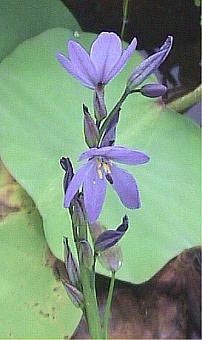Weeds
Monochoria korsakowii Regel et Maack - Korsakov.s Monochoria.
Systematic position.
Family Pontederiaceae Kunth, genus Monochoria C. Presl.Morphology and biology.
Annual herbaceous plant. Stem 40-60 cm. The radical leaves with long petioles and with ovate-cordate, rarer lanceolate-ovoid, or even lanceolate blade, (3) 5 - 10 (12) x (1.5) 3 - 7 (9) cm. Two stem leaves are usually smaller, than radical leaves, closely approaching to each other, with swollen vaginas. The perianth is blue, somewhat irregularly shaped, (18) 20 - 30 (35) mm in diameter. Inflorescences spike-liked, having (3) 5 - 15 (20) flowers. The fruit is triquetrous rounded capsule. One plant produces to 20 thousand small seeds. The shoots appear in June, being resistant to floods. The water layer up to 30 cm in height does not impede the seeds growth. Flowering from July to September.Distribution.
The Far East of Russia (southern Primorskii Territory); introduced in the Caucasus, Ukraine, Manchuria, North China.Ecology.
Korsakov.s Monochoria grows in standing waters, on the banks of reservoirs, on abandoned rice plantations. It is a heliophyte. Thick rice plantations depress Monochoria korsakowii.Economic significance.
Segetal-ruderal weed plant on rice. Control measures include seed cleaning by a seed-cleaning machine and well-timed harvesting of the crop.Related references:
Kharkevich, S.S., ed. 1987. Vascular plants of the Soviet Far East. V. 2. Leningrad: Nauka, 424 p. (in Russian).Komarov, V.L., ed. 1934-1964. Flora of the USSR. (in Russian).
Nikitin, V.V. 1983. Weed plants of the USSR flora. Leningrad: Nauka, 454 p. (in Russian).


